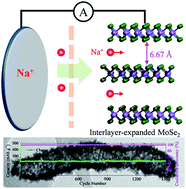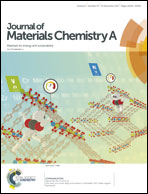Hierarchical nanotubes constructed from interlayer-expanded MoSe2 nanosheets as a highly durable electrode for sodium storage†
Abstract
Sodium-ion batteries (SIBs) are considered as a promising energy storage device, but suffer from poor cycling performance. In this work, hierarchical MoSe2 nanotubes have been synthesized for the first time and demonstrated as a highly durable electrode material of SIBs. The hierarchical nanotubes consist of few-layered MoSe2 nanosheets with an expanded (002) interlayer spacing of 1.00 nm (54.8% expansion). The growth of hierarchical nanotubes is a result of oriented attachment and Ostwald ripening effects. As a robust sodium host material, the MoSe2 nanotubes featuring hierarchical organization, hollow interiors, and interlayer expansion are beneficial for (i) lowering diffusion energy barriers and facilitating fast Na+ insertion/extraction reaction kinetics, (ii) accommodating volume changes upon sodiation/desodiation, (iii) preserving structural and morphological stability, and (iv) improving electronic conductivity by in situ carbon modification. By controlling the cut-off voltage in the range of 0.5–3.0 V with an intercalation mechanism, the MoSe2 nanotube electrode shows highly stable cycling performance and delivers a reversible discharge capacity of 228 mA h g−1 after 1500 cycles at a high current density of 1000 mA g−1. This work demonstrates the best cycling performance to date of MoSe2-based anodes for SIBs.



 Please wait while we load your content...
Please wait while we load your content...